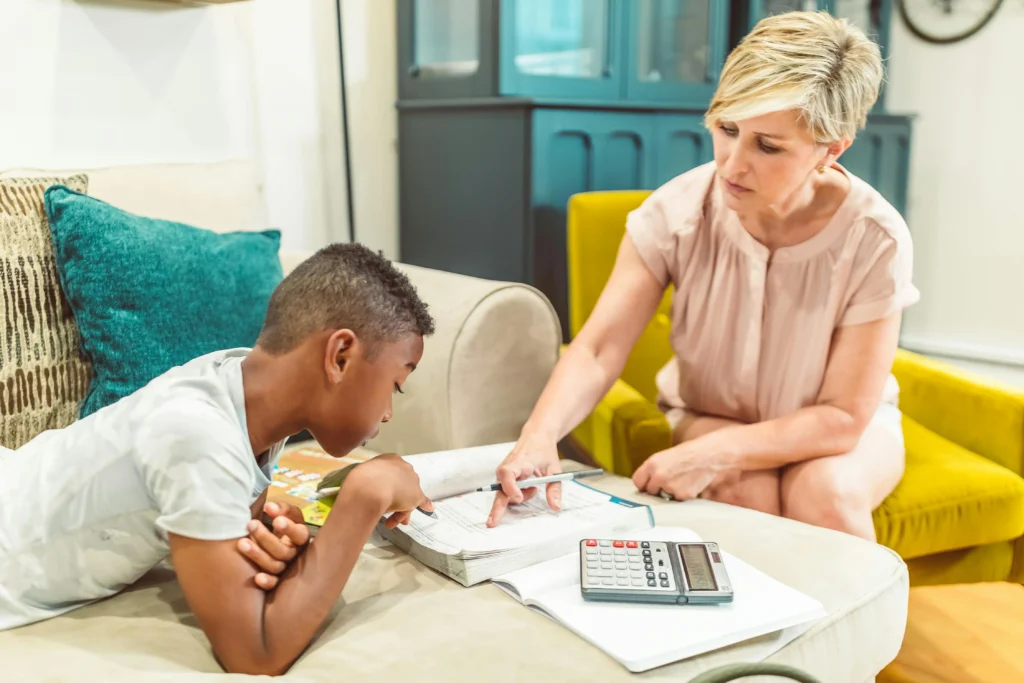The Confident Parent’s Guide to Efficient Homeschooling (in just 15 hours a week!)
Did you know that can give your children an excellent education at home in just 15 (ish) hours a week? That might be a surprising idea if you think about kids being in school for seven hours a day, five days a week. Can homeschooling really get the same or better result in less than half the time?
Think about what happens in a traditional classroom. Twenty or thirty students are trying to learn the same things at the same time. The teacher has to manage all those students and try to keep everyone in sync. Time is spent lining up, moving between classrooms, sharpening pencils, and tying shoelaces. When the learning finally starts, the teacher has to review concepts some children mastered weeks ago, while others may have missed a day or need more practice, and now they’re left behind.
But in homeschooling? You’re working one-on-one with your child. Every day you pick up exactly where you left off, move at exactly the right pace, and focus precisely on what your child needs right now. There is no “left behind” or “catching up”. There’s only continued learning, one day at a time.
I’ve spent years helping families develop efficient homeschool planning strategies that work for their unique situations. Today, I’m sharing a framework that you can adapt to fit your family’s needs – whether you’re just starting your homeschool journey or looking to make your current approach more efficient.

Table of Contents
The Foundation: What Really Matters
When I talk about 15 hours of homeschooling, I’m talking about the focused time you’ll spend working with your kids on parent-led, foundational learning. But what exactly does that mean?
What Makes Learning “Foundational”?
Foundational learning means mastering the core academic subjects that enable all other learning: literature, language, writing, math, history, and science. These aren’t just “subjects” – they’re the fundamental domains of human understanding that we draw from whenever we want to learn or do anything else.
Think of these foundations like the basic ingredients in cooking. Just as you need to understand how flour, eggs, and butter work together before you can create your own recipes, your child needs these core subjects to develop their own understanding of the world. Each subject builds on itself and connects with the others, creating a web of knowledge that supports all future learning.
Goodbye to Busywork
One of the key principles of efficient homeschooling is eliminating busywork – those time-filling activities that don’t contribute to real learning. In a classroom, teachers sometimes need activities to manage a large group. But in homeschooling? Every minute of our academic time is spent either building new understanding or providing necessary practice to master a concept. Sitting at a desk filling out worksheets does not need to be a regular part of your day (unless you have a kid who loves worksheets!).
How to Recognize What Really Matters
How do you know if something is truly foundational? Ask yourself: “Does this help my child understand other things? Does it build their ability to learn and think?” If you’re just memorizing isolated facts – if your quizzes feel suspiciously like questions from a trivia game show – that’s probably not foundational learning. What we want to focus on is ideas that connect to other ideas and help explain how the world works. That’s foundational learning, and that’s where the real value is in a primary education.
Why 15 Hours is Enough
This is why 15 hours is enough – because we’re using that time efficiently and purposefully. We’re not reviewing concepts your child has already mastered just because others in a class need that review. We’re not pushing ahead before they’re ready just to keep pace with a group. Instead, we’re always working at exactly the right level, providing exactly the practice they need, and making adjustments as soon as we see they’re needed. That’s the power of one-on-one instruction focused on what really matters.

Efficient Homeschooling at Every Age
One of the most common questions I hear from parents is “How many hours a week should my child spend on homeschool?” This is also one of the common questions that homeschooling parents get from concerned relatives and neighbours – how could your kids be learning enough if they’re always playing outside while other kids are still in school?
I’ve already explained that homeschool can be done in fewer hours a week because one-on-one instruction is naturally much more efficient. Still, the exact number of hours you’ll need will vary by age, development, and individual needs. Here’s a basic framework I’ve worked out to help you get a sense of what a homeschool can look like at each age. You can grab the free printable file to refer to as you plan your days (or to explain what you’re doing to your mother-in-law 😉).
Looking at this chart, you might notice that even at the high school level, the hours are significantly lower than at traditional school. Believe me, it’s not because they’re doing any less work. It’s because we’re working “smarter, not harder”. Let me explain how these hours work at each stage. I’ve listed approximate ages, but of course individual children will be ready to move to the next stage at different times. Follow your child – there’s nothing to “keep up” with and no need to push them or slow them down.
Preschool (age 0-4): Play-Based Foundations
At this stage, there’s no need for formal “school time” at all. Your role is to create an enriching environment and engage in plenty of play-based learning. Read lots of books together, create art, and let your child’s curiosity lead the way. Meanwhile, this is a great time for you to read books about education if you are planning on homeschooling. A couple of my favourites for this stage are this one and this one.
Transition to School (age 4-6): Learning to Learn
This is often the trickiest stage for homeschool families because we have to start adding focused learning time into our routines. This is the time to build “cues” for learning. Start small – maybe 5-10 minutes of math after breakfast and some reading together after lunch. Much of their learning at this stage will still happen through play, as you help them build their attention span and ability to focus as well as the routines of learning together.
Early Elementary (age 6-9): Building the Basics
At this stage, children are ready for more structured learning, but we’re still keeping it efficient with only a couple of hours of homeschooling per day. They’ll be working on crucial foundational skills in math, reading, and handwriting, and starting to build some basic knowledge in science and history through lots of reading and hands-on activities.
Upper Elementary (age 9-12)
This is when we transition from “learning to read” to “reading to learn”. You’ll be spending 15-20 (at most) hours per week on formal learning, covering all the core subjects every week – literature, grammar or second language, writing, math, science, and history. Parent involvement in learning is still high at this stage, but your child is probably starting to become more independent outside of school time.
Junior High (age 12-15)
While maintaining about 15-20 hours of formal learning during school weeks, this stage is about gradually building independence. Children should start to have some control over when and how they complete their work so they can develop time management and organization skills. The parent still needs to be involved in assigning, checking, and helping when needed, and family discussions are always valuable, but this is the beginning of more independence.
High School & Higher Learning (age 15+)
At this stage, students might actually spend more than 15 or 20 hours weekly on academics, depending on their goals, but parent involvement can be quite a bit less. Many homeschooling students at the high school level take outside classes or online courses for most of their schoolwork, so your role shifts to more of a facilitator or mentor. You’re helping them figure out what their goals are and how to reach them.
Remember, these are guidelines, not rules. Every child develops differently, and efficient homeschooling means adapting to your child’s unique needs.
Setting Up Your Homeschool Week
Most homeschooling parents want to know exactly how to schedule these 15 hours. I’ll be writing another post soon with examples of homeschool schedules from real families, so you can see how different this can look depending on your family’s needs and other demands on your schedule. The best schedule for you is the one you’ll actually be able to stick to – the one that gets the work done.
When you’re just starting out, you probably won’t know exactly what will work for you yet. It also takes time for you and your kids to adjust to a new routine. Let me show you how to build a personalized homeschooling schedule when you’re just starting out.
Start Small and Build
Don’t try to plan out your entire week before you begin. Instead, start with just one or two subjects that are either:
- Something you’re confident about teaching, or
- Something your child is excited about learning
The idea here is to set yourself up for success by choosing the one or two easiest things to do. You can expect that there will still be some resistance to a new routine (from you and your kids!). That’s normal – old habits die hard, as they say. It helps to have something to look forward to, so start out with something fun or easy.
Maybe you start by reading together after breakfast and doing two pages of math. Once that becomes routine, add another subject. Then add a lunch break and a couple more subjects in the afternoon. Or perhaps you do science after breakfast and reading before bed. The specific pattern doesn’t matter – what matters is starting with something manageable and building from there.
Creating Learning Cues
One challenge of homeschooling is that your home environment usually signals “play time” or “relaxation” – not learning time. In traditional schools, kids have strong environmental cues: getting dressed, packing lunch, riding the bus, entering a classroom. We need to create our own gentle cues at home to help transition into learning time.
These cues don’t need to be elaborate. Try some of these:
- Using meals as transition points (“after breakfast we do math”)
- Having a designated shelf for homeschool materials
- A specific spot on the couch for reading together
- A regular workspace, even if it’s just the dining room table
The point is to have certain spaces, times, and activities in your day that become associated with doing schoolwork. This makes it much easier to build a reliable routine and transition into school time each day without feeling distracted or resistant.
Quality Over Quantity
Think about what happens in most math lessons at school. A child might spend an hour doing 30 problems, half of which they already understand perfectly. In efficient homeschooling, you might spend just 20 minutes doing 5-10 problems, but you’re choosing exactly the right problems for where your child is right now. You’re watching how they solve each one, catching small misunderstandings before they become big problems, and moving forward only when they’re truly ready.
The same principle applies to every subject. When you’re reading history together, you can pause to discuss interesting connections. When you’re practicing writing, you can focus on the specific skills your child needs most. There’s no need to keep pace with a classroom or fill a certain number of minutes – you just need to make steady progress.
Your Role as a Teacher
One of the best things about homeschooling is being able to match your child’s natural learning pace. You can tell learning is working when your child asks curious questions, connects ideas on their own, and explains things in their own words.
But what about the times when your child gets stuck? This is when homeschooling really helps. You can slow down and try new ways to explain tricky ideas. You might discover gaps in their understanding that need filling. Sometimes the best choice is to take a break and come back later. I’ve seen kids make huge leaps forward after stepping away from a hard concept for a while.
You don’t need to be an expert to teach well. What matters is watching how your child learns and knowing where to find help when you need it. Real learning takes time – time to think, time to understand, and time to grow. When we rush through lessons just to check boxes, we miss the chance to let true understanding grow deep roots.

Beyond Core Academic Time
When you first hear “15 hours a week,” you might wonder: what happens during all the other hours? Let’s talk about what the rest of homeschool life looks like.
Learning Happens Naturally
The truth is that your children are learning all the time. Every game they play, every conversation they have, every problem they solve is a learning opportunity. They can have more of these opportunities at home because they are making more decisions about what to, rather than being told what to do all day by a teacher. When you’re covering the foundations during your academic time, you can relax and let natural learning unfold during the rest of the day.
You don’t have to turn every cookie-baking session into a math lesson. You don’t have to quiz them about science while they’re playing in the backyard. Instead, you can simply be present and go about your business, answering their questions as they arise or helping out when you need to, and trust that they’re growing and learning in their own way.
The Childcare Question
Every family’s journey with work and homeschooling looks different, and it changes as your kids grow. In my family, when my kids were little, I couldn’t work from home without help – I needed childcare to get anything done. As the kids got older, doors started to open. Once my youngest turned six, I could manage part-time work from home while teaching them.
Now my kids are 9 and 12, and everything has changed. Both my husband and I work full time from home now, and we don’t need extra childcare. Our children have learned to play independently, and they know when to ask for help. This didn’t happen overnight – it came from years of building routines and helping our kids learn to manage their own time. It’s also possible because we’re lucky enough to both be working from home with flexible schedules.
If you’re in those early years right now, be patient with yourself. The intense hands-on stage doesn’t last forever. Your children’s growing independence will gradually give you more flexibility in your work life. The key is matching your work expectations to your children’s current ages and abilities, not the other way around.
Activities and Socialization
Your children can have as many structured activities as fit your family’s needs. This might include:
- Library programs
- Homeschool co-ops
- Sports teams
- Art classes
- Community groups like 4H or Scouts
- Community theatre
- Music lessons
The key is matching activities to your individual children’s needs. Some kids thrive with a busy schedule of outside activities, while others prefer more quiet time at home. There’s no universal “right amount” – it’s about finding what works for your family.
The Parent’s Role
Outside of academic time, you’re still teaching – just in a more natural way. Your children learn from:
- Watching you manage your daily life
- Helping with household projects
- Planning family activities
- Exploring their interests
- Interacting with different people and places
Most importantly, they learn from who you are and how you live. You’re teaching them through example, whether you’re fixing a leaky faucet, planning a vacation, or pursuing your own interests.
The beauty of separating core academic time from everything else is that both parts of life become more enjoyable. During school time, you focus on building strong foundations. The rest of the time, you can relax and watch learning unfold naturally, knowing you’re giving your children both the structure they need and the freedom they deserve.

Common Concerns and Solutions
I hear certain questions again and again when I talk about this 15-hour approach. Let’s address them directly.
“Are we doing enough?”
If you’re spending focused time on foundational subjects and seeing your child make progress, you’re doing enough. Remember: we’re not trying to recreate school at home – we’re creating something better. When you remove busywork and inefficient classroom management, 15 hours of focused learning is remarkably productive.
“What about keeping up with peers?”
One-on-one instruction is incredibly efficient. Your child won’t fall behind by spending less time on academics – in fact, they’re likely to move ahead in areas that matter because they’re getting personalized attention and moving at exactly the right pace.
“What about everything else?”
That’s exactly the point – by containing “school” to 15 efficient hours, you create space for everything else. Art, music, sports, coding, cooking, entrepreneurship – whatever interests your child can pursue. The foundation you’re building during academic time will support all these other pursuits.
How to Get Started With Efficient Homeschooling
The 15-hour homeschool framework isn’t about doing less – it’s about doing what matters, doing it well, and then having the freedom to live a rich and interesting life beyond academics.
When you separate core academic time from everything else, you give your children two precious gifts:
- A strong foundation in essential subjects
- Time and space to become themselves
You don’t have to implement this all at once. Start with one subject you’re confident about teaching, establish that routine, then gradually build from there. Trust that by focusing on what truly matters during your academic time, you’re giving your children exactly what they need to thrive.
Ready to get started? Choose one subject and one time of day. Then, begin building your confident, efficient homeschool.











2 Comments